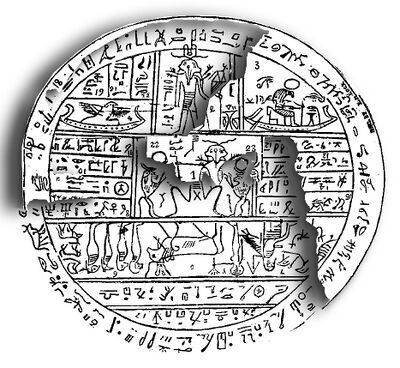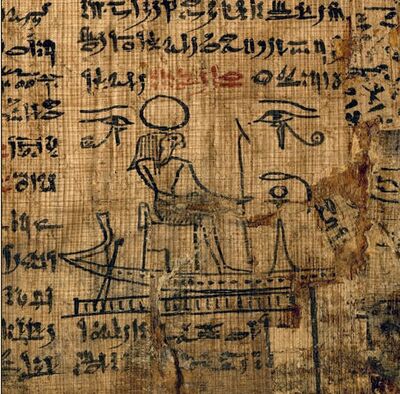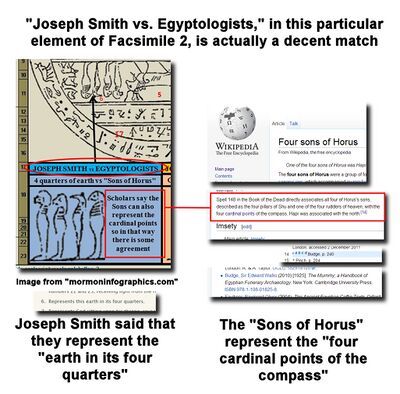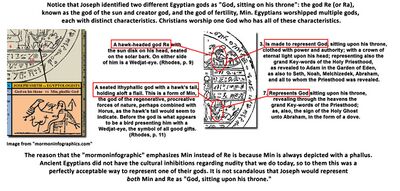
FAIR is a non-profit organization dedicated to providing well-documented answers to criticisms of the doctrine, practice, and history of The Church of Jesus Christ of Latter-day Saints.
(m) |
(m) |
||
| Line 1: | Line 1: | ||
{{Articles FAIR copyright}} {{Articles Header 1}} {{Articles Header 2}} {{Articles Header 3}} {{Articles Header 4}} {{Articles Header 5}} {{Articles Header 6}} {{Articles Header 7}} {{Articles Header 8}} {{Articles Header 9}} {{Articles Header 10}} | {{Articles FAIR copyright}} {{Articles Header 1}} {{Articles Header 2}} {{Articles Header 3}} {{Articles Header 4}} {{Articles Header 5}} {{Articles Header 6}} {{Articles Header 7}} {{Articles Header 8}} {{Articles Header 9}} {{Articles Header 10}} | ||
{{Resource Title|Book of Abraham Facsimile 2: The hypocephalus}} | {{Resource Title|Book of Abraham Facsimile 2: The hypocephalus}} | ||
[[File:Hypocephalus.split.3D.1.jpg| | [[File:Hypocephalus.split.3D.1.jpg|400 px|thumb|right|Missing sections of Facsimile 2 and the "restorations" added before publication (Click to enlarge)]] | ||
[[File:Hawk-headed.god.Re.in.Joseph.Smith.Papyri.jpg| | [[File:Hawk-headed.god.Re.in.Joseph.Smith.Papyri.jpg|400 px|thumb|right|(Click to enlarge)]] | ||
[[File:Mormoninfographic.facsimile2.sons.of.horus.jpg| | [[File:Mormoninfographic.facsimile2.sons.of.horus.jpg|400 px|right|(Click to enlarge)]] | ||
[[File:Mormoninfographic.min.the.ithyphallic.god.jpg| | [[File:Mormoninfographic.min.the.ithyphallic.god.jpg|400 px|thumb|right|References in the figure are to Michael D. Rhodes, "The Joseph Smith Hypocephalus . . . Twenty Years Later." {{link|url=http://home.comcast.net/~michael.rhodes/JosephSmithHypocephalus.pdf}}]] | ||
== == | == == | ||
{{Criticism label}} | {{Criticism label}} | ||




The illustration represented by Facsimile 2 (view) is a hypocephalus, a disc made of linen, papyrus, or bronze, covered with inscriptions and images which relate to one of the last spells in the Book of the Dead. The disc was placed under the head (hypocephalus = Greek: "under the head") of the deceased in the belief that the spell would cause the head and body to be enveloped in flames or radiance, making the deceased divine. Joseph Smith's notes to Facsimile 2 identify several figures as representing God sitting in the heavens among the stars and others of his creations.
Criticisms related to Facsimile 2 are related to Joseph Smith's explanations of the individual elements.
Regarding Facsimile 2, it should be noted that portions of the original Facsimile 2 appear to have been missing, and that the missing portions were filled in with characters or images taken from other sources before the image was published in the Times and Seasons. Some material was copied from the Joseph Smith papyri. Among the missing sections may have been the area identified as section #3, which matches a figure which appears on Joseph Smith Papyrus IV. One interesting thing about this restoration is that the figure in the bark boat actually does appear in this section of at least one other hypocephalus. }}
One critic of Mormonism states, "The following is a side-by-side comparison of what Joseph Smith translated in Facsimile #2 versus what it actually says according to Egyptologists and modern Egyptology." The letter displays a graphic from "mormoninfographics.com" called "The Book of Abraham - Hypocephalus, a funerary amulet," which compares Joseph Smith's interpretations of elements of Facsimile 2 with those provided by Egyptologists. Although this is an anti-Mormon source, the graphic acknowledges that Joseph may have gotten an element correct: "there is some agreement."
Critics of the Church focus on one element of Facsimile 2 in which Joseph identified the Egyptian god "Min" as "God sitting on his throne." For example, the author of the Mormon "exit story" known as the "Letter to a CES Editor" states, "One of the most disturbing facts I discovered in my research of Facsimile 2 is figure #7. Joseph Smith said that this is “God sitting on his throne…” It’s actually Min, the pagan Egyptian god of fertility or sex. Min is sitting on a throne with an erect penis (which can be seen in the figure). In other words, Joseph Smith is saying that this figure with an erect penis is Heavenly Father sitting on his throne."
The Egyptians had multiple gods, each representing a particular characteristic. Latter-day Saints, (and Christians in general), on the other hand, worship one God, who encompasses all characteristics. Thus, Joseph could have identified any Egyptian god in Facsimile 2 as "God, sitting on his throne," not just Min. He does, in fact, also identify the hawk-headed god Re in the exact same manner. The is no Egyptian representation of the God that we know as "God the Father."
With regard to the nudity (and the phallus in particular), the Egyptians had no cultural reservations about depicting nudity, unlike our current society. Therefore, the depiction of Min and his phallus is used by critics to create an absurdity: that Joseph would dare to associate such a figure with God the Father. To ancient Egyptians, however, there would have been no absurdity in doing so. Joseph simply equated both the god Re and the god Min with "God sitting on his throne."
}}

FAIR is a non-profit organization dedicated to providing well-documented answers to criticisms of the doctrine, practice, and history of The Church of Jesus Christ of Latter-day Saints.
We are a volunteer organization. We invite you to give back.
Donate Now